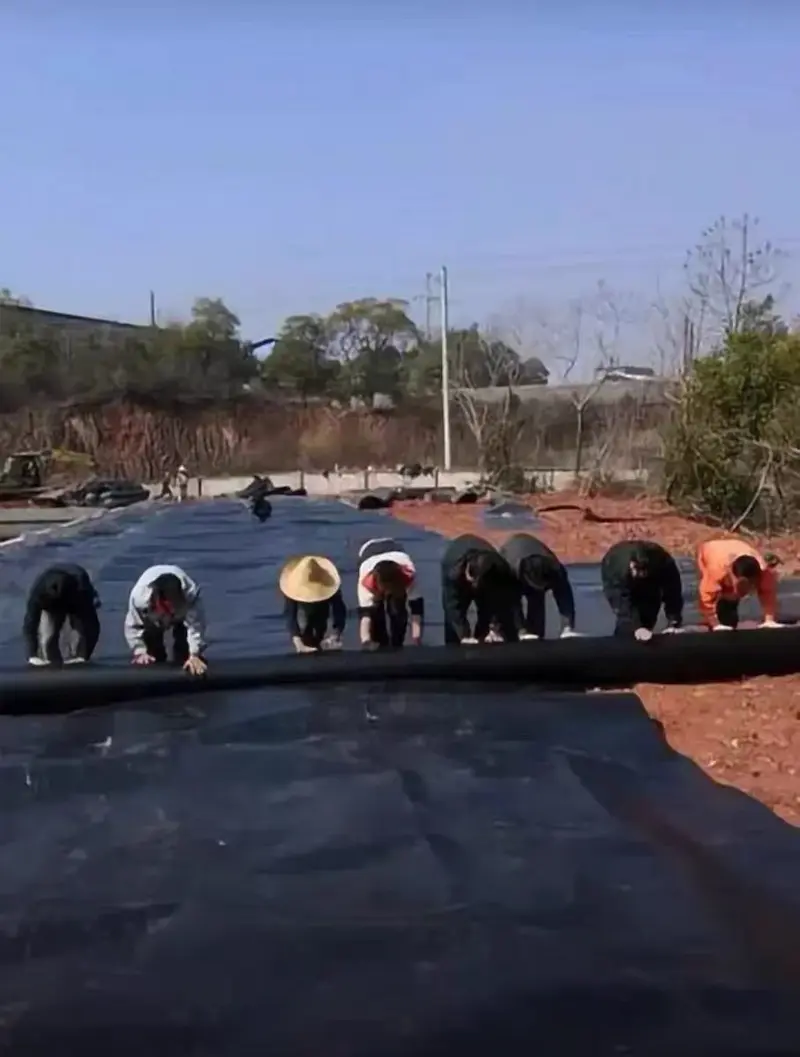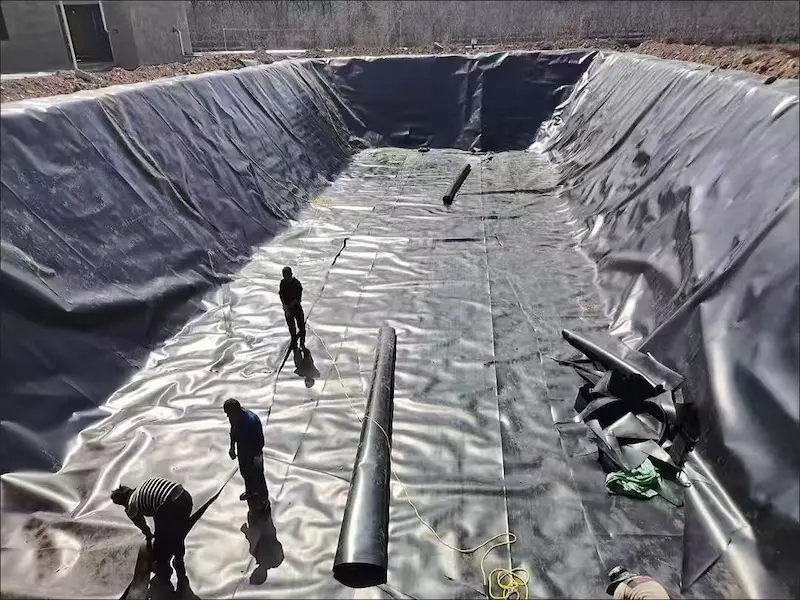Step by step guide for using HDPE geomembrane correctly(I-V)
I、Before the construction of HDPE geomembrane, how to prepare the site and materials?
(1) Site treatment
Before laying HDPE geomembrane, ensure that the construction site meets the requirements. The site should be smooth and solid, and there should be no pointed debris such as roots and stones within 2.5cm vertical depth, so as not to Pierce the geomembrane. For the slope of the site, the slope should be above 2%, easy to drain. In addition, the site needs to be compacted, the compaction degree reaches 95%, and the subsequent laying work can be carried out after the rolling is qualified.
(2) Preparation of materials and tools
For the purchased HDPE geomembrane, check the quality certification documents, and carry out appearance inspection to see if there are problems such as damage and holes. At the same time, the physical performance index is re-tested to ensure that the material meets the design requirements. In addition, prepare the welding machine, sand bag, anchorage belt, cutting tools, etc. required for construction.
II. How to lay HDPE geomembrane scientifically to reduce weld hazards?
(1) Precise cutting
Before cutting HDPE geomembrane, it is necessary to accurately measure the size of the laying site and cut it according to actual requirements. In order to avoid errors, each piece of geomembrane should be individually numbered and the relevant information should be recorded in detail.
(2) Determine the laying sequence
It is usually extended from the bottom to the top, while reserving 1.5% of the remaining width to cope with local subsidence and stretching. When the slope is laid, the order from top to bottom can be taken. The longitudinal joints of the two adjacent panels should not be on the same horizontal line, and should be staggered by more than 1 meter. The longitudinal joints should be more than 1.5 meters away from the dam foot and the bend foot, and should be located on the plane as far as possible.
(3) Laying operation
During the laying process, the number of welds should be reduced as much as possible, which can save raw materials and help ensure the quality of construction. The lap width of the joint between the film and the film is generally not less than 10 cm, and the weld should be arranged along the direction of the maximum slope. When laying, it is necessary to avoid artificial folding, and when the temperature is low, the geomembrane should be tightened and flattened as far as possible.

III. Hot melt welding HDPE geomembrae, how to control and adjust the parameters?
(1) Preparation before welding
Before welding, test welding should be performed with a hot wedger welding machine. Adjust the pressure, temperature and speed of the welder, test weld on the HDPE geomembrane sample, and test the tension and shear of the sample. At the same time, ensure that the welding joints are clean and free of impurities such as grease, dust, soil and so on.
(2) Formal welding operation
The common welding method is hot melt welding, which uses the hot melt welding machine to weld the geomembrane. Take the common climbing welding machine as an example, connect the 220V power supply, turn on the switch, adjust the temperature knob to more than 350 ° C, the speed switch to about 4, and start welding when the temperature rises and the red light turns on. During the welding process, the welder should be kept at a constant speed, and the speed and temperature should be fine-tuned according to the field situation.
(3) Handling of special cases
When the length of geomembrane is insufficient, longitudinal splicing is needed. At this time, the transverse weld should be completed first, and then the longitudinal seam should be welded, and the meeting point of the longitudinal and transverse welds should be reinforced by an extrusion welding machine.

IV.What are the practical methods for fixing and protecting HDPE geomembrane?
(1) anchoring and fixing
At the edge of the geomembrane, anchorage bands are used to fix it to the ground or to the base. For the site with anchoring ditch, the geomembrane is laid in the anchoring ditch, and then pressed with concrete slab to achieve fixation. In the center of the slope, the buffer platform can be added, and the anchoring ditch can be set on the platform to reduce the lower tension of the geomembrane and increase the stability.
(2) Surface covering
After the geomembrane is laid and welded, it is necessary to cover a protective layer on its surface, such as geotextile, sand, etc., to prevent the geomembrane from being damaged by direct sunlight and external force, etc., and extend its service life.
V. How to use a variety of detection methods to ensure the construction quality of geomembrane?
(1) Appearance inspection
Carry out a comprehensive appearance inspection of the laid geomembrane to check whether the film surface is damaged, holes, folds and other problems, whether the weld is neat and beautiful, and whether there is slip welding or skip welding.
(2) Weld detection
Aeration method: The air tightness of the double welds is tested by aeration method. The gas of a certain pressure (0.15-0.20MPa) is sealed in the air cavity and kept for more than 2 minutes. If the pressure gauge is stable, the weld is qualified.
(3) repair treatment
The problems found in the inspection should be repaired in time. For small holes or holes, spot welding or squeeze welding can be used to repair; When the hole is larger than 5 mm, it should be repaired with a 10 cm round or oval liner.
 (1)494594.webp)
VI、Summarize
When using HDPE geomembrane, prepare the site and materials before construction, accurately measure and reasonably bond during laying, determine parameters and fine-tune in time during welding stage, anchor and fix after completion, cover protection, and repair defects through strict quality testing. Only when all links are closely connected and strictly follow the specifications, can the anti-seepage efficiency of HDPE geomemofilm be fully brought into play and the long-term stability of the project be guaranteed.
![]() Company overview and certificates.pdf
Company overview and certificates.pdf
![]() Haoyang environmental catalogue.pdf
Haoyang environmental catalogue.pdf
If you have any needs or want to know about geomembrane products, please feel free to contact me.
Below is my contact information
Tel/whatsapp:86-18105413386
E-mail:Annie@hygeosynthetics.com
446.webp)
897.webp)
942.webp)
237.webp)